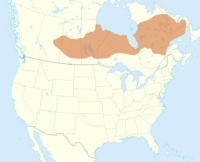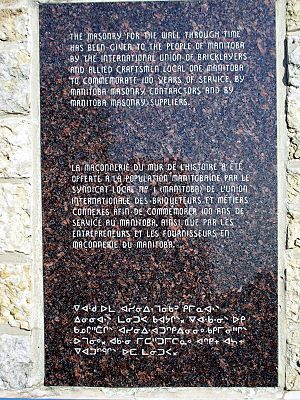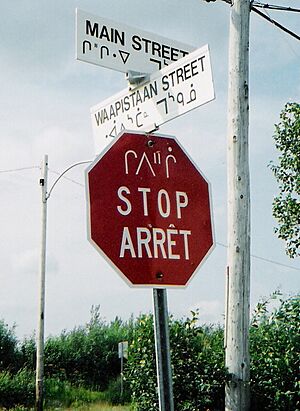Cree language facts for kids
Quick facts for kids Cree |
||||
|---|---|---|---|---|
| ᓀᐦᐃᔭᐍᐏᐣ, nēhiyawēwin (Plains) ᓃᐦᐃᖬᐑᐏᐣ, nīhithawīwin (Woods) ᓀᐦᐃᓇᐌᐎᐣ, nêhinawêwin (W Swampy) ᐃᓂᓃᒧᐎᓐ, ininîmowin (E Swampy) Template:Crl-Cans, Iyiniu-Ayamiwin (N Eastern) Template:Crj-Cans, Iyiyiu-Ayamiwin (S Eastern) |
||||

Historical distribution of Cree peoples
|
||||
| Native to | Canada; United States (Montana) | |||
| Ethnicity | Cree | |||
| Native speakers | 96,000, 27% of ethnic population (2016 census) (including Montagnais–Naskapi and Atikamekw) |
|||
| Language family |
Algic
|
|||
| Writing system | Latin, Canadian Aboriginal syllabics (Cree) | |||
| Official status | ||||
| Official language in | ||||
| Recognised minority language in | ||||

|
||||
|
||||
The Cree language (pronounced KREE) is a group of related languages spoken by Indigenous people across Canada. You can find Cree speakers from the Northwest Territories all the way to Labrador. In 2021, about 86,475 people spoke Cree. This makes it the Indigenous language with the most speakers in Canada.
Cree is an official language only in the Northwest Territories. There, it is spoken mainly in Fort Smith and Hay River.
Contents
What are the different Cree dialects?
Cree is not just one language. It is a group of many different dialects. Think of it like different accents or versions of English. These dialects are part of the Algonquian languages family.
How did Cree languages develop?
Experts believe the Cree language started about 2,500 to 3,000 years ago. It began near the Great Lakes. Speakers of this early Cree language then moved north. They split into two main groups near James Bay. The eastern group's language changed into different dialects over time. The western group's language changed much later. It is hard to know exactly how these groups moved. This is because there were no written records. Also, Indigenous people often learned new languages from their neighbors.
Some historians thought Cree people moved west only after 1670. This was when they got European firearms. However, newer evidence suggests Cree people were already living as far west as Peace River Region in Alberta before Europeans arrived.
How do Cree dialects differ?
The different Cree dialects can be grouped by how they pronounce certain sounds. One big difference is how they say a sound that was once like the "l" in English.
- Plains Cree (spoken in Saskatchewan, Alberta, British Columbia, Northwest Territories) uses a "y" sound. For example, 'native person' is iyiniw.
- Woods Cree (Manitoba, Saskatchewan) uses a "th" sound. For example, 'native person' is ithiniw.
- Swampy Cree (Ontario, Manitoba, Saskatchewan) uses an "n" sound. For example, 'native person' is ininiw.
- Moose Cree (Ontario) uses an "l" sound. For example, 'native person' is ililiw.
- Atikamekw (Quebec) uses an "r" sound. For example, 'native person' is iriniw.
- East Cree (Quebec) also uses a "y" sound.
- Naskapi (Quebec) uses a "y" sound.
- Montagnais (Quebec, Newfoundland and Labrador) uses "l" or "n" sounds.
These sound differences help linguists group the dialects. Sometimes, Cree is divided into two main languages: Cree and Montagnais. This is based on another sound change.
How is Cree written?
Most Cree dialects are written using a special writing system called Cree syllabics. This system is unique to Indigenous languages in Canada. Cree can also be written using the Latin script, which is the alphabet English uses. Both ways of writing show how the language sounds. Cree is always written from left to right.
The dialects in eastern Quebec and Labrador only use the Latin alphabet. Other dialects use different versions of Cree syllabics.
Cree Syllabics Explained
In Cree syllabics, each symbol stands for a consonant sound. The way the symbol is turned shows which vowel sound goes with it. For example, the symbol for 'p' can be turned to mean 'pe', 'pi', 'po', or 'pa'. Some dialects have more vowels, so they add small marks to the symbols. Separate symbols are used for single consonant sounds at the end of words.
Writing Cree with the Latin Alphabet
For dialects like Plains Cree and Swampy Cree, a system called Standard Roman Orthography (SRO) is used. It uses 14 letters from the Latin alphabet. These letters represent 10 consonant sounds and 7 vowel sounds. Unlike English, Cree usually does not use capital letters.
Long vowel sounds are shown with a line above the letter (like ā) or a hat (like â). For example, nēhiyawēwin is Plains Cree for 'Cree language'.
Cree sentences can be very long. One word can mean a whole phrase in English. For example, kiskinohamātowikamikw means 'school'. It literally means 'knowing-it-together-by-example place'.
The order of words in a Cree sentence can change. This helps to put emphasis on different parts of the sentence. For example:
- kakwēcimēw kisēýiniwa means 'He asked the old man.'
- kisēýiniwa kakwēcimēw means 'It was the old man he asked.'
What are Cree contact languages?
Cree has mixed with other languages to create new ones. These are called contact languages. Some examples are Michif, Northern Michif, Bungi, Oji-Cree, and Nehipwat.
- Michif mixes Cree with French. It mostly uses Cree verbs and French nouns. Michif is spoken in parts of Canada and the United States.
- Bungi is a mix of Scottish English, Scots, Scottish Gaelic, Cree, and Ojibwe. It was spoken in Manitoba in the 1800s. Now, it is almost gone.
- Nehipwat is a mix of Cree and Assiniboine. It is spoken in a few places in Saskatchewan and is also close to disappearing.
Why has the Cree language been lost?
Sadly, many Cree speakers have stopped using their language over the years. There are a few reasons for this:
- Residential Schools: These schools made children feel that their language was not good. Students learned English at school, but their Cree language skills did not grow. When they left, they often had trouble speaking with elders.
- Moving Away: Many Indigenous families moved away from their home communities. Often, elders stayed behind. This broke the tradition of elders teaching the language to younger generations.
- Personal Choice: Some parents stopped teaching Cree to their children. They believed it would help their children succeed in the world and avoid unfair treatment.
What is the legal status of Cree?
The importance of Cree changes across Canada. It is one of 11 official languages in the Northwest Territories. In Northern Quebec, it is one of two main languages for the local government.
In 2019, Robert Falcon Ouellette, a Cree Member of Parliament, helped make a big change. He worked to allow Indigenous languages to be spoken in the Canadian House of Commons. This means that Cree and other Indigenous languages can now be used in Parliament with translation services. This was a historic moment for Indigenous languages in Canada.
Also, the Indigenous Languages Act was passed in 2019. This law helps to protect and bring back Indigenous languages across Canada. It provides money and support to keep these languages alive.
How is Cree being supported?
Many people are working to keep the Cree language strong. Here are some ways:
- In Quebec, some schools now teach in Cree.
- The Mistissini council decided in 1991 that their employees should learn Cree syllabics.
- The Cree School Board now shares its yearly report in both English and Cree.
- There is a push to have more Cree radio stations.
- In 2013, free Cree language e-books became available for teachers in Alberta.
- The Government of the Northwest Territories creates reports on Indigenous languages. They have made a guide about medicinal plants in both Cree and English. They also helped dub a movie into Cree. They are working on a radio station for Indigenous languages.
- Writers like Joshua Whitehead are using the Cree language in their poetry.
Images for kids
See also
- Cree people
- In Spanish: Idioma cree para niños




